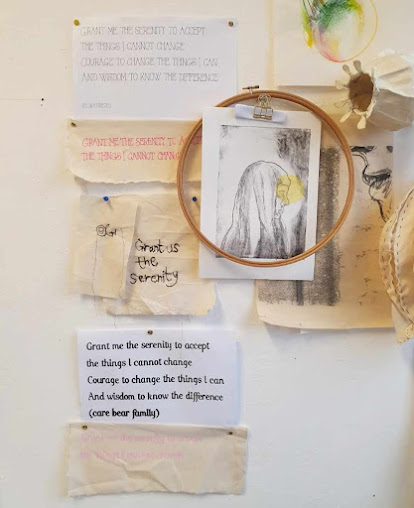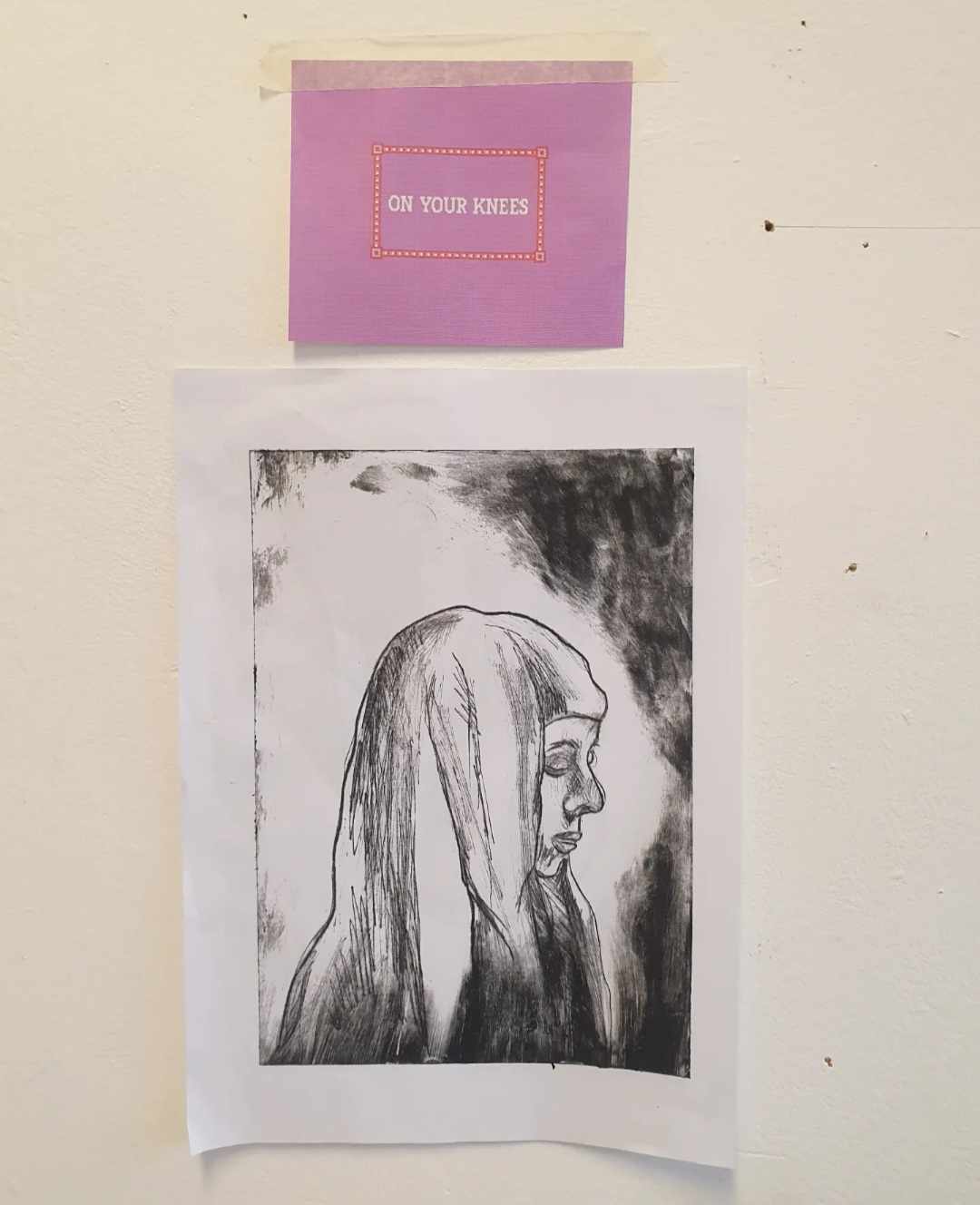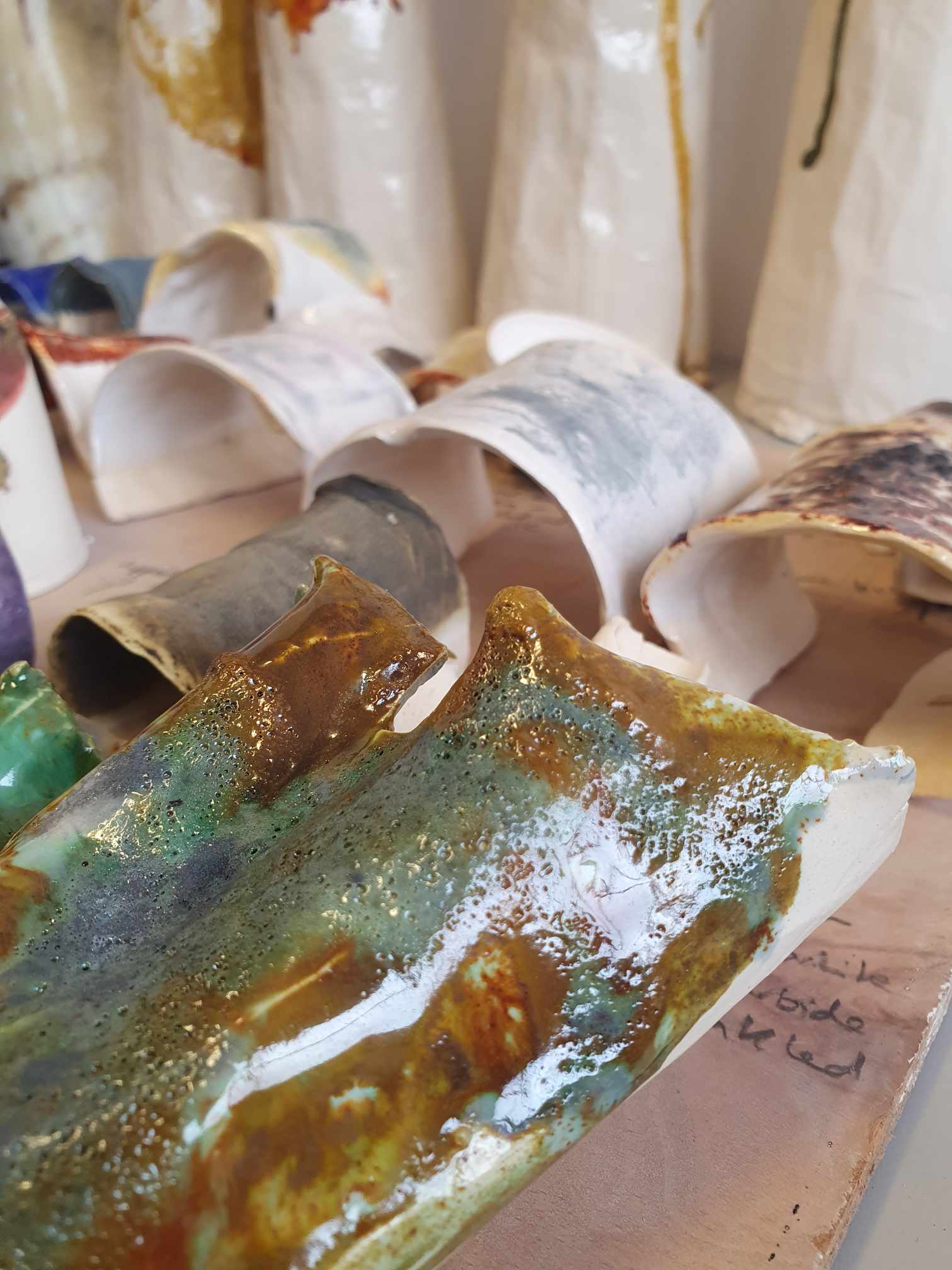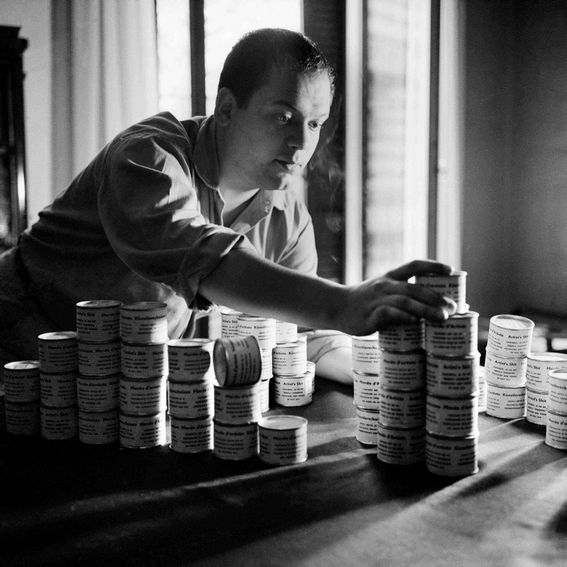



I enjoyed and found lots of merit in this first project of the course for lots of different reasons. It facilitated me connecting with a lot of staff and studio spaces which I appreciated. And it also encouraged self led practise which I appreciate as I work well in this manner.
I had the opportunity to really delve into ceramics which is something that I have never done before. I learned lots of techniques including slip casting and glazing; I enjoyed both so much that I would definitely like to explore these disciplines more in the future.
I personally found it a steep learning curve in some ways. For one I was stepping back into full time education that focused on my own needs, which took a little adjustment; I had to wrangle a bit with some parental guilt around that. And it was a reminder that it can feel easy to do what you are good at (in my case research and concept development). But harder to step into endeavour that feels intimidating (in my case just getting stuck into open ended making and showing up in studio space). After I got over this initial block, I was really connected with my making process and made prolifically across discipline. It made me consider that I enjoy crossing boundaries of medium and feel like I lean towards multi-discipline work.
I am happy with how I interpreted the brief and really enjoyed researching and reinterpreting what I decided to focus on which was desire lines; lines made by repetitive organic relationship with space and collective anarchy. I like how I tied the project into our local and historic landscape of Sherwood Forest while also exploring something else close to my heart that looks to the future; environmentalism and grazing ecology.
What I think is most valuable to take away, is that my favourite pieces from this project were without exception the makes that came out of experimentation and translation.
The rough stitch landscapes that I decided to frame were actually the reverse of the works because I found the back stitches far more interesting visually and powerful conceptually. The back works embodied more of the chaos of the desire paths I was painting in thread and the quality of the stitch feels wild and feral, like the landscape and animals it represents. If I were to expand on this I would play around with scale, creating much larger pieces, and I would also would mess about with the visual script of the piece; using neon or primary colours in the thread for more impact and edge in the piece.
While I am proud of my slip cast horn pieces because of the sheer volume of work and patience that went into the process of making them, I prefer the organic uncontrived and experimental quality of my ceramic test pieces.


Transgression
and Taste
‘Transgression does not deny the taboo
but it transcends and completes it.’
Georges Bataille – Eroticism, 1986
I
am interested in considering if being transgressive adds value to a piece of
art, because this is something I find myself being drawn to exploring in my own
work. Transgression requires the consideration of a cultural social line in the
sand about taste and what is and isn’t acceptable. But this line is relative
and constantly in flux; it is dependent on context influences like time,
location and the social group(s) being included in the discussion.
The
ancient Greeks had a strong focus on homoeroticism and their whole society was
very male centric. Women were considered equivalent to slaves and men were considered
equal and compatible sexually because they had a biological and cultural understanding of one another. These
attitudes were challenged by the onset of Christianity, which morally condemned
and repressed homosexuality. It is only recently, and only in certain parts of
the world, that we see open queerness being normalized and celebrated once
more. This is a historic example of how ideas of transgression are fluid. That something can be acceptable or unacceptable, depending on the social
constructs of the time.
A quality
of this fluidity is that there is a subtle language and visual script around what
is considered transgressive. And it is the duty of the rebellious artist, the
artist who wants to engage in currently relevant conversation and achieve impact by being transgressive, to
interpret this language, to find these lines in the sand, explore and then exceed
them where necessary.
This
kind of art usually focuses on sensitive themes such as violence, sex and
religion. These themes aren’t normally depicted in a literal way. It is arguable that there are
two clear artistic approaches to taste and transgression. Either
the visual evidence presented is offensive or challenging in some way, for
example ‘Artist’s Shit’ by Piero Manzoni where the medium is literally cans of the artist’s feces. Or, the art actively seeks to push buttons in an attempt to illuminate and or shift
public opinion, for example ‘Olympia’ by Édouard Manet which played with
societal boundaries by representing a woman masturbating as an empowered sex
worker. So much so that it required a police guard to prevent vandalism when it
was first exhibited.
‘Olympia’, Édouard
Manet, 1856
When looking at this kind of art, we can reflect on whether the artist is being transgressive in their materials choice, through what they are representing, or both.
It
is often employed as a creative choice by artists who want to affect positive
shifts in individual and collective attitudes. A contemporary example of this
is Grayson Perry, who explores his childhood trauma and scripts around male
behavior through artwork and public performance including cross dressing. His
public embracing of transvestitism has been hugely powerful and he is
celebrated as such because he has fuelled debate and helped public attitudes be
less harming and more inclusive in this area. In this way, I believe that transgression
can be merit worthy.
However,
transgressive art can be a creative cul de sac, because what shocked your
audience the first time won’t shock the second because they have been
desensitized. Some artists survive this by becoming more imaginative in
carrying their ideas forward. But you can end up being pigeon holed as a
sensational artist; and this can foster cynicism around your work.
Contemporary artists consistently flip the high art narrative intentionally to be transgressive; by
playing with what is and isn’t classically considered noteworthy. And there is value
attached to this endeavour as well as the scandal it often generates. Artists frequently use sensationalism to promote
their work and escalate their price. A good example of this is Maurizio Cattelan,
who’s work skyrocketed in value after ‘La Nona Oram’; an installation piece
that irreverently plays with the impotence and hypocrisy of the Catholic church
with the visual reference of the Pope being struck down by a meteorite as an
act of God.
‘La
Nona Oram’, Maurizio
Cattelan, 2016
Transgressive
artists often embody their work themselves and we see this most commonly in
body art, a movement that started in the 1960s and still persists today. It
includes a huge variety of approaches but most often, performance art or
actionism. It has a focus on the relationship of body and mind.
My
preferred example of this is body and endurance artist Marina Abramović who’s
Rhythm series defined the genre and it’s participatory quality; with an open
invitation being extended for her audience to relate, or not, to her body using
a catalogue of objects including weapons.
‘Rhythm
0’, Marina
Abramović, 1974
To
further explore taste and transgression, I will look at some more artists and
their relevant works now.
Best
known for his ‘Great Wave’, Katsushika Hokusai and his Shunga paintings are an
excellent example of early transgressive art. It is erotic and humorous and intends
to explicitly depict sexual acts, including female gratification, which was as rare
at the time as it is today. The government attempted to ban his works repeatedly but
this verboten quality only added to their popularity and they were allegedly secretly
cherished and shared by families and lovers because of their humor but also
because they facilitated healthy conversations about sexual intimacy.
‘The
Dream Of The Fisherman’s Wife’, Katsushika
Hokusai, 1814
Picasso’s
‘La Reve’ subtly portrays his mistress masturbating while dreaming of his penis.
Not so subtly hiding an abstraction of his penis in his lovers face was extremely
risqué for the time and still feels like a pretty dick move.
‘La Reve’, Pablo Picasso, 1932
Marcel
Duchamp is best known for his urinal piece, but I wanted to look at his assemblage ‘Étant
Donnés’, which requires his audience to look at a disconcerting painting
through a pair of peepholes in a door, creating a sense of being a disempowered
voyeur to an ambiguous scene that has undertones of a crime scene. It is
transgressive in physical construct because it is forcing challenge around the
traditional relationship that audience has with paintings and viewing them. And
it was the absolute opposite of what a lot of his contemporaries were doing at
the time which again makes it sensational.
‘Étant Donnés’, Marcel
Duchamp, 1966
War
art is endemically transgressive because of its subject. A clear example of
this is Francisco de Goya’s ‘Los Desastres de la Guerra’ which took around 50
years to be printed, so sensational and horrific was it considered. In it’s
attempts to lay bare the grisly truth of war.
Damien Hirst rebels and does not emulate the art world’s requirements, rather
choosing to present as an everyman. In this way he is good at self-branding as
the transgressor and this choice has gained him even more notoriety. One of his
most famous pieces ‘The Physical Impossibility of Death in the Mind of Someone
Living’ explores exactly what the title suggests; the challenge of being human
and grappling with existential crisis like death.
‘The
Physical Impossibility of Death in the Mind of Someone Living’, Damien
Hirst, 1991
Looking
at our limited ability to conceive of death and the fears we hold around it culturally
as a concept is a really relatable topic; it is one of the great unifiers
because it happens to us all. He created this installation, which displays an
iconic apex predator that still looks alive and as if it is swimming towards
you. A thing that brings death, that is in fact already dead itself even though
it has been manipulated and displayed to look alive.
What
he is talking about is really important thematically and his transgressive
approach gives the conversation buckets of impact and depth.
While
on the subject of things suspended in formaldehyde, it feels pertinent to
mention the Chinese conceptual artist Xiao Yu whose piece ‘Ruan’ raises a discussion
about science, genetic modification and how dangerous and complicated that area
is using really graphic medium. Reading his statements about what he makes yields the truth that it is because of his care and respect for the sanctity of life that he feels so compelled to create visually abhorrent version’s of it in reference to his concerns about medical ethical abuse.
‘Ruan’, Xiao
Yu, 2005
Street
artists are transgressive because their work is illegal by definition and often
involves sensational political commentary; hence the need to often protect
their identity in order to avoid prosecution and other negative repercussions
for their work.
‘No
Future’, Banksy, Unknown
date
We
have seen a rise in the popularity and commodification of street art in recent
years with artist like Banksy exhibiting in gallery spaces and selling prints
of their work; quite a feat to have bridged the gap between alleged criminal to
globally successful artist.
The
artist collective Led by Donkeys create politically motivated art in public
spaces. Their most recent installation on Bournemouth beach which included a
line of children’s clothing laid on the sand in reference to the atrocities and
death currently happening in Gaza was their effort in appeal to cease fire and
has caused as much support as it has kick back.
Gaza installation on Bournemouth beach, Led
by Donkeys, 2024
Cultural
attitude and taste evolve over time and what was once perceived as sensational
and radical, for example Impressionist painting, can overtime loose that
quality of impact. An interesting question is, is there something that is
ultimately always going to be transgressive, regardless of the society. The
public’s visceral and negative reaction to ‘Myra’ by Marcus Harvey, a portrait
of the infamous child serial killer Myra Hindley made up children’s handprints,
indicate that abuse and harm of children is fundamentally unacceptable and makes us deeply
uncomfortable to witness or be made aware of. However, this is not absolute,
because if it were then the aforementioned Led by Donkeys piece would not have
cause to exist. What kind of transgressive art would it take to shake us out of this collective contradiction?
‘Myra’, Marcus
Harvey, 1995
In
summary, I think it is clear that transgression does have its place in the art world
as a tool for engagement and impact. Although what will impact any given culture
varies hugely over time and place, artists clearly feel compelled to connect
with this means of eliciting response for their work and the themes and topics
they are trying to create dialogue about.
Ultimately
I believe that it is you as the artist, your supporters and the creative community
you are a part of who decide whether your transgressive art has purpose and achieves
the intended impact.
In
my opinion, an artist trying to make sincere comment about something is valid;
however offensive or challenging it might be in medium or theme.
Bibliography
https://journal.media-culture.org.au/index.php/mcjournal/article/view/781
https://www.britannica.com/topic/aesthetics/Taste-criticism-and-judgment
https://www.bbc.co.uk/news/magazine-30343083
https://www.thecollector.com/georges-batailles-erotism-religion-death/
https://bmcr.brynmawr.edu/2008/2008.07.20
https://www.tate.org.uk/art/artworks/manzoni-artists-shit-t07667
https://www.artribune.com/television/2018/03/video-7-artisti-commentano-piero-manzoni/
https://www.manet.org/olympia.jsp
https://www.saatchigallery.com/artist/grayson_perry
https://www.britishmuseum.org/collection/object/H_2012-8013-1
https://www.tate.org.uk/art/artists/sir-grayson-perry-cbe-ra-4657
https://www.youtube.com/watch?v=_Yboc75WufE
https://www.huffpost.com/entry/post_b_6561968
https://en.wikipedia.org/wiki/Marina_Abramovi%C4%87
https://www.theguardian.com/artanddesign/2023/sep/19/marina-abramovic-royal-academy-retrospective
https://www.royalacademy.org.uk/article/marina-abramovic-interview
https://www.tate.org.uk/art/art-terms/b/body-art
https://en.wikipedia.org/wiki/Hokusai
https://artfilemagazine.com/le-reve-by-pablo-picasso/
https://www.toutfait.com/marcel-duchamp-atant-donnas-the-deconstructed-painting/
https://en.wikipedia.org/wiki/%C3%89tant_donn%C3%A9s
https://uk.search.yahoo.com/search?fr=mcafee&type=E211GB714G0&p=goya+war
https://www.bbc.com/culture/article/20140717-the-greatest-war-art-ever
https://www.tate.org.uk/art/artists/damien-hirst-2308
https://www.youtube.com/watch?v=13ShK2UAeP0
https://en.wikipedia.org/wiki/The_Physical_Impossibility_of_Death_in_the_Mind_of_Someone_Living
https://ocula.com/artists/xiao-yu/
https://www.chinadaily.com.cn/english/doc/2005-08/10/content_467851.htm
https://en.wikipedia.org/wiki/Banksy
https://www.artofthestate.co.uk/archive/banksy-2/banksy_no_future/
https://www.bbc.co.uk/news/uk-england-hampshire-11827202
Subverting the idea of value. Collecting things that are mubdane and ordering them to look like a collection. Bottle tops/ jar lids/ stones/ Annabelles floor treasure
We all have a collection if them so it’s relatable